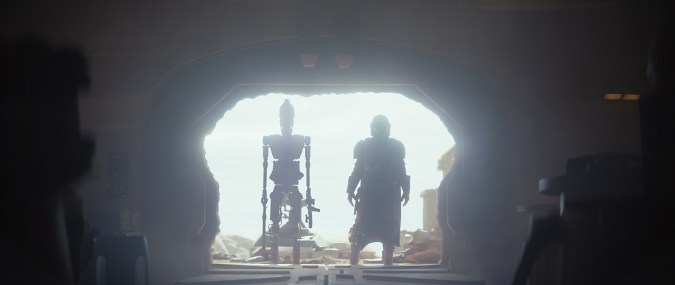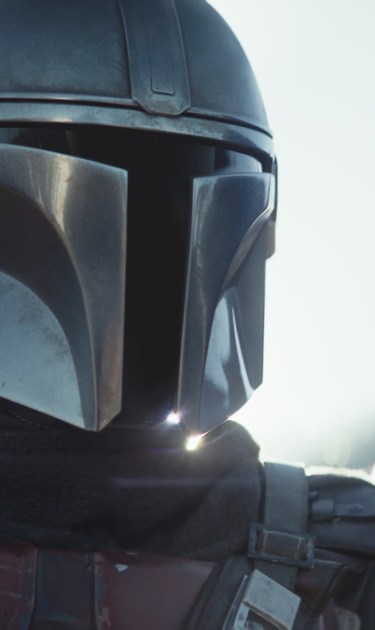The quintessential Star Wars story is that of the orphan. Anakin. Luke. Rey. Integral to their storylines, which now span three separate and interconnected trilogies, is the tragedy that they didn’t grow up within traditional homes (and some of them without loving families to care for them). Such sacrifices hardened them, made them better Jedis (or Siths, as the case may be) as they sought surrogate father figures. It’s no surprise to find that the very first live-action Star Wars television series would delve into this well-worn trope from that galaxy far, far away. For, if the first episode of The Mandalorian is any indication, we are getting yet another story of a young orphan whose life gets upended by the seismic political changes happening all around the galaxy.
Stoic as they come, Pedro Pascal’s The Mandalorian is immediately presented as a cool and collected kind of guy.
But that’s not where The Mandalorian starts. As a live-action televisual outgrowth of the four decades’ old franchise, this Jon Favreau-penned and -produced series is intent on both offering lifelong fans much of what they love, while also opening up a new chapter (and a new world) that exists right alongside the Skywalker saga. Taking place a few years following Return of the Jedi (the final installment in the original trilogy), this self-described “space Western” opens where else but in a cantina, the kind that’s been a staple of these films going back to the iconic introduction of one Han Solo in A New Hope. Han was introduced needing to flee a bounty hunter. Here, we get to see what a more ruthless kind of bounty hunter can look like. Stoic as they come, Pedro Pascal’s The Mandalorian (don’t go mistaking him for Boba Fett) is immediately presented as a cool and collected kind of guy. He’s unfazed when he earns the ire of some rabble-rousers at the bar (he dispenses with them with little effort) and mostly tackles his interaction with his prized bounty in laconic exchanges that show him being all business.
In other words: Given that we don’t get to see his face under his helmet (“Is it true that you guys never take off your helmets?” he’s asked), The Mandalorian is the quintessential mystery man at the heart of the Westerns that Favreau’s drama is clearly emulating. His gruff if efficient demeanor is what sets him apart from the rest of the bounty hunters around. And it’s what lands him the most important and lucrative job of his career: to secure an asset (alive, he’s told at first; though dead wouldn’t be a problem) of which he gets very few descriptions. That job eventually leads him to a desolate landscape where he has to learn how to ride a Blurrg (a ridiculous-looking two-legged animal) and later to a safeguarded area where he’s outnumbered (a shoot out ensues, naturally) where he meets a humorless droid (voiced by Taika Waititi), who offers some lighthearted moments during its climactic sequence.

Throughout this first episode, we learn very little about our titular protagonist. We get a few flashbacks that inform us of a traumatic event involving his parents, who may or may not have had to leave him behind for his own safety. And we only get snippets of information from the many supporting characters that populate the show about what’s been going on around the galaxy since the Rebel Alliance succeeded in taking down the Empire. The Mandalorian doesn’t ask you to be a diehard fan. It wants to stand on its own even as it’s painting a world with borrowed brushes and color palettes: Its landscapes, droids, cantinas, ships and aliens aren’t out of place in the larger universe George Lucas created. Its action sequences – which in this first episode include a tusked ice monster – look right at home next to moments in Hoth in Empire Strikes Back, while its final image (no spoilers) anchors the story of this lone gunman squarely within an instantly iconic image from the franchise.
There are diversions, though. Ludwig Göransson’s woodwind-heavy score is a clear departure from John Williams’s iconic orchestrations; and while the Star Wars films are known for their propulsive storytelling, there’s a quiet stillness about The Mandalorian. Its long wide shots of beautiful desert-like scenery (whether icy or sandy) suggest vastness and tranquility, as if, like its titular character, the action series was all too confident about where it’s going to try and rush to it. What remains to be seen is whether we’ll also have The Mandalorian’s patience to see whether the Chilean-born American actor who portrays him gets to actually emote and build a character with so little body language and no facial gestures to speak of.
Ambitious in scope and terribly pretty to look at, The Mandalorian is a quintessential Star Wars story: The jury’s still out whether it can stand on its own, orphaned from the franchise that created him and that it so clearly wants to leave aside.
The Mandalorian premiered November 12, 2019 on Disney+. New episodes will air on Fridays.




